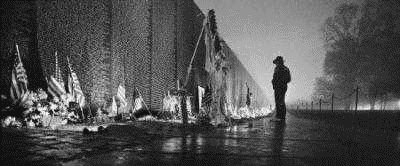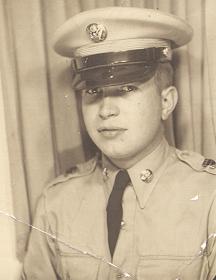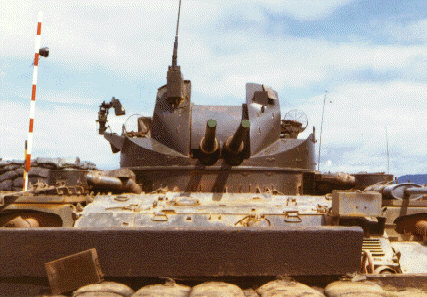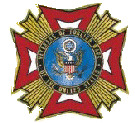
Raymond Leroy Burrows Jr.'s Tour of Duty was 05JUN68 to 04JUN69.

He was awarded the Bronze Star for Meritorious Service, the Vietnam Campaign Ribbon with four or five stars, and the Vietnam Service Ribbon. Except for the Bronze Star, all you had to do was be there to get the other ribbons and stars. His unit was recommended for either the Presidential Unit Citation or the Congressional Unit Citation. He doesn't know if either was awarded but he believes they did get the latter of the two.
He was trained as a Battalion (Bn) Maintenance Officer at Ft. Knox, KY before going to Vietnam. He was scheduled to go to an 8" Field Artillery outfit as their Maintenance Officer but, knowing the Artillery Branch would soon split into Field Artillery and Air Defense Artillery (ADA), he requested to be switched over to the Duster Bn in that area.
A Duster Bn consists of five batteries (Headquarters and Headquarters Battery (HHB), and four lettered firing batteries (A,B,C and D)), an attached "Quad 50" battery (Btry) and a Searchlight Btry. The Bn Maint. Officer is a member of the Bn Commander's staff and is responsible for the upkeep of all of the functional parts of the Bn. Every piece of equipment must be able to "move, shoot, and communicate". After all, a tank that can't shoot is nothing more than a 24 ton portable radio.
A Bn staff consists of the Bn Commander (BnCO), Executive Officer (XO), and five staff sections. S-1 (Personnel), S-2 (Military Intelligence), S-3 (Operations and Training), S-4 (Supply), and, in wartime, an S-5 (which deals with co-ordination of the Bn's activities with the surrounding population, sort of a Public Relations job.) Then there are the Special Staff Officers, Chaplain, Surgeon, Communications Officer and Bn Maint. Officer.
By being switched over to the ADA Bn, they already had a Bn Maint. Officer so he originally was assigned as the Asst. S-2 with the additional duty of S-5. He became the Bn Maint. Officer about half way through the tour. Both jobs required him to visit all of the firing btrys and their individual detached units. He would deliver parts and personnel to repair what they could "on-site". So he saw all of South Vietnam from the DMZ (the line between North and South Vietnam) to just north of Saigon. He didn't make it to Saigon or the Delta area.
Most of the travel was by helicopter. The rest was by jeep or truck. Very seldom did he spend a night away from the base camp of HHB, at first at Qui Nhon (pronounced QuinYon) on the east coast and then at AhnKe (Pronounced OnKay) in the central highlands. When he did spend a night away, it was usually in a Special Forces compound or an authorized hotel in one of the larger towns. The Special Forces compounds were the most secure. Once in a while they would get caught on the road late enough to have to spend the night at a bridge head. They closed the roads at night and if you didn't get back to camp or to a big town, you had to stay there. The bridges under control of the ROK's (Republic of Korea forces) were the most secure.
The only time he came close to getting hurt was in a mortar attack on the base camp at AhnKe. He got a scratch on my left knee deep enough to draw blood but couldn't prove it was caused by shrapnel so didn't get a purple heart. He really didn't care at the time but it would have been of benefit to him after he got out. All in all, he had a pretty easy time over there. He didn't have to wander around in the jungle or hide from Vietcong or see anyone get blown away. He did walk down a few dirt roads dealing with the local populace and almost drove down a road which they later found out was mined. They usually went down that road to a firing range where they took new soldiers to teach them how to fire their weapons and safely handle claymore mines and other devices they might run into over there. They all had been trained to fire their weapons in basic training stateside but they wanted to be sure they could function under stress. He also taught them survival, evasion, and escape techniques. Anyway, they were going out that day and decided they didn't have enough people to train to make it worthwhile so they didn't go. Later a sweep team working outside of the base camp found mines on the road.
He was also in great demand as a defense council for soldiers facing courts martial for what ever reason. He won several and lost a few but, the more he won, the greater the demand was for him to represent them. He even got chewed out by the BnCO once for winning a case where they were trying to "board out" a soldier. He chewed out the whole board and my father saying, "When our BnCO wants a man out, he WILL be boarded out. No matter what the circumstances are." He told him that he did his job and he should direct his ire at the "prosecutor" (not what the BnCO's representative is called but it's actually what he does.) Little things like this is probably what got him RIF'd years later.
These were posted by another artillery unit so didn't have really good pictures of the DQS units. The Quad 50 guntruck is pretty good. These were elements of his unit 4/60 Artillery.



The fact that they made it back home means the world to me because a lot of men/boys don't.
© 1999 - 2006
Send E-mail to inhonor_2000@yahoo.com 
He is a current member of the Veterans Of Foreign Wars and BPO of Elks.


Created 11/6/00
Last Updated 09/24/08